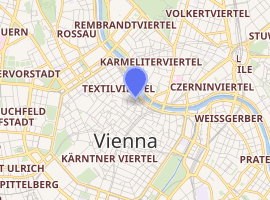Hotel Metropole, Vienna
Hotel Metropole was a hotel in Vienna, Austria that was constructed in 1871–73. It was destroyed during World War II after serving as the Vienna headquarters of the Gestapo from 1938. The address was Morzinplatz, in the I. District Innere Stadt.
| Hotel Metropole | |
|---|---|
Old daguerrotype of the Hotel Metropole in the back | |

| |
| General information | |
| Location | Morzinplatz, Vienna, Austria |
| Opening | 1873 |
| Closed | 1938 (ceased to be hotel) ca1940 (destroyed by bombing) |
| Design and construction | |
| Architect | Carl Schumann (architect) Ludwig Tischler |

History
The hotel was built for the Vienna World Exhibition and was designed by Carl Schumann and Ludwig Tischler. The four-story building was richly decorated with Corinthian columns, caryatids and atlases. The inner court was glassed over and had a richly decorated dining hall.[1]
After the Anschluss of Austria to Nazi Germany in March 1938, the hotel was confiscated by the Gestapo who made it their headquarters. With a staff of 900 (80 per cent of whom were recruited from the Austrian police), it was the largest Gestapo office outside of Berlin. Many people, especially Jews, were interrogated or tortured there.[2][3] During the war the building was hit by a bomb and burned down and ultimately the ruins were torn down to eliminate any memory of the building.
In 1951 a memorial stone was erected by concentration camp survivors, which was then replaced in 1985 with a bigger monument financed by the city of Vienna. The monument consists of granite blocks from the quarry of the former concentration camp at Mauthausen and a bronze statue symbolising a survivor. The inscription comes from the president of the association of the survivors of the concentration camps Wilhelm Steiner and reads:
(German) "Hier stand das Haus der Gestapo. Es war für die Bekenner Österreichs die Hölle. Es war für viele von ihnen der Vorhof des Todes. Es ist in Trümmer gesunken wie das Tausendjährige Reich. Österreich aber ist wiederauferstanden und mit ihm unsere Toten, die unsterblichen Opfer."
(English) "Here stood the House of the Gestapo. To those who believed in Austria it was hell. To many it was the gates to death. It sank into ruins just like the 'Thousand Year Reich'. But Austria was resurrected and with her our dead, the immortal victims."
On June 13, 2015, as part of the theatre festival Wiener Festwochen, a group of artists (Zsuzsi Flohr, Benjy Fox-Rosen, Eduard Freudmann, Eva Reinold, Luisa Ziaja) illegally erected a meta-memorial dedicated to the survivors who had illegally erected a monument on that spot in 1951.[4] The inscription reads:
(German) "Was sie unterließ, haben wir getan. Den Errichter_innen eines nie errichteten Obelisken am 11. April 1951 um 19 Uhr 20."
(English) "What they neglected we did. To the erectors of a never erected obelisk on April 11, 1951, at 7.20 pm."
References
- pg. 121, Dieter Klein, Martin Kupf, Robert Schediwy (Ed.) Stadtbildverluste Wien - Ein Rückblick auf fünf Jahrzehnte. LIT Verlag, Vienna 2005. ISBN 3-8258-7754-X
- "Morzinplatz memorial site for the victims of National Socialism". wien.gv.at. Retrieved 15 July 2017.
- Anderson, Christopher (1 November 2011). "Crossing the Painful Threshold of Memory". Vienna Review. Archived from the original on 22 March 2016. Retrieved 18 March 2016.CS1 maint: ref=harv (link)
- "Gedenkstein Was sie unterließ, haben wir getan – Wien Geschichte Wiki". www.wien.gv.at (in German). Retrieved 2018-07-13.
External links
| Wikimedia Commons has media related to Hotel Metropole, Vienna. |